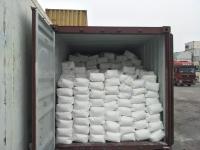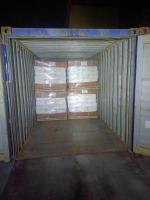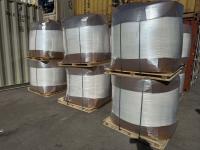Our Products
Polyacrylamide / The application of Hydroxamated polyacrylamide (HPAAM) used in red mud setting
835_small.jpg)
Application of Hydroxamated Polyacrylamide (HPAAM) in Red Mud Settling
Hydroxamated Polyacrylamide (HPAAM) is a modified water-soluble polymer derived from polyacrylamide, in which part of the amide groups have been chemically converted into hydroxamic acid functional groups. This unique structure gives HPAAM the ability to selectively bind with metal oxides, making it an effective flocculant for applications involving the separation of solid particles from liquid phases, especially in the context of red mud settling in alumina refineries.
Red mud is a highly alkaline industrial waste byproduct generated during the Bayer process, the primary method used to extract alumina (Al₂O₃) from bauxite ore. Efficient management and separation of red mud from the caustic aluminate solution are crucial for ensuring high recovery rates, minimizing environmental impact, and reducing operating costs. HPAAM plays a central role in optimizing this separation process.
Understanding Red Mud in the Bayer Process
The Bayer process involves digesting crushed bauxite in a concentrated caustic soda solution at high temperatures and pressures. During this process, the aluminum oxide in bauxite dissolves to form sodium aluminate, while insoluble impurities—primarily iron oxides, silica, titanium dioxide, and undigested bauxite minerals—are left behind. These insoluble residues form a thick slurry known as red mud.
Red mud must be separated from the sodium aluminate solution before aluminum hydroxide can be precipitated. However, due to the fine particle size, colloidal nature, and high pH of the slurry, red mud tends to remain suspended, making separation difficult. Without an effective flocculant, red mud settling would be too slow, leading to process bottlenecks and inefficiencies.
Role of HPAAM in Red Mud Settling
Hydroxamated polyacrylamide (HPAAM) is specifically designed for selective flocculation of red mud particles, especially those rich in iron and aluminum oxides. Its hydroxamic acid groups exhibit strong chelating affinity toward trivalent metal ions (such as Fe³⁺ and Al³⁺) that are abundantly present in red mud. This characteristic provides several key advantages:
1. Selective Adsorption on Iron- and Aluminum-Rich Particles
HPAAM can selectively attach to particles containing iron and aluminum oxides due to its hydroxamic acid functionality. This selectivity helps to form flocs preferentially from the suspended red mud particles, enhancing sedimentation efficiency while minimizing unwanted polymer loss to the clear liquor.
2. Polymer Bridging and Aggregation
Like conventional flocculants, HPAAM has a long polymer backbone that can span between particles, bridging them together into larger aggregates or "flocs." These flocs are denser, heavier, and settle more quickly than individual particles.
3. Rapid Settling and Clarification
Once flocs are formed, they settle to the bottom of the thickener or clarifier. The overhead liquor—rich in sodium aluminate—is then cleaner and contains fewer fine solids, which improves downstream processes such as aluminum hydroxide precipitation and filtration.
4. Better Underflow Density
The flocs produced by HPAAM promote the formation of a denser underflow, meaning more solids are concentrated per unit volume of slurry. This contributes to improved washing, lower waste volumes, and easier handling of the red mud.
Advantages of HPAAM in Red Mud Flocculation
HPAAM offers multiple process, environmental, and economic benefits, particularly in high-pH, high-temperature conditions typical of Bayer process thickeners:
-
Effective at high pH (up to pH 14): HPAAM maintains its performance even in highly alkaline environments.
-
High thermal stability: Withstands temperatures common in digesters and settlers.
-
Reduced chemical consumption: High efficiency allows for lower dosage compared to traditional flocculants.
-
Improved caustic soda recovery: Better separation reduces caustic entrapment in red mud, lowering chemical loss.
-
Enhanced throughput: Faster settling allows for higher capacity operations.
-
Minimized environmental impact: Denser mud with less entrained liquor reduces the potential for caustic leakage in red mud disposal areas.
Application Conditions
To use HPAAM effectively in red mud separation, attention must be given to the following operational parameters:
-
Dosage point: Typically added just before or in the primary thickener. It may also be used in secondary settlers or washers.
-
Dosage rate: Varies depending on the bauxite quality, red mud characteristics, and process conditions. Commonly used in small concentrations (e.g., 5–30 ppm).
-
Solution preparation: Usually prepared as a dilute solution (0.1–0.5%) to ensure even dispersion and maximize contact with suspended particles.
-
Mixing and retention time: Adequate mixing and residence time are needed for full floc formation and settling to occur.
Typical Applications in Alumina Refineries
-
Primary Mud Settlers: The first step in separating red mud from sodium aluminate liquor. HPAAM helps to accelerate settling and improve overflow clarity.
-
Red Mud Washers: In multi-stage washing systems (counter-current decantation), HPAAM can be used to maintain floc integrity and maximize caustic soda recovery from red mud.
-
Mud Thickeners and Storage Tanks: In some operations, HPAAM is added to increase the solids content before mud disposal, improving handling and environmental control.
Compatibility with Other Reagents
HPAAM is typically compatible with:
-
Sodium hydroxide (NaOH) at high pH
-
Conventional polyacrylamide flocculants (may be used together in staged flocculation systems)
-
Oxidizing environments (due to its relatively stable structure)
However, it may be sensitive to high shear, which can degrade its polymer structure. Proper mixing and dosing protocols are therefore essential.
Summary
Hydroxamated Polyacrylamide (HPAAM) is a highly effective flocculant designed to enhance the performance of red mud settling in alumina refineries. Its unique hydroxamic acid groups enable selective interaction with iron and aluminum oxides, making it ideal for improving solid-liquid separation in the Bayer process. By using HPAAM, aluminum plants benefit from:
-
Faster red mud settling
-
Clearer overflow liquor
-
Higher underflow density
-
Improved caustic soda recovery
-
Lower chemical consumption
-
Enhanced process throughput
The use of HPAAM in red mud separation represents a significant advancement in flocculant technology, ensuring both operational efficiency and environmental responsibility in the production of alumina.





